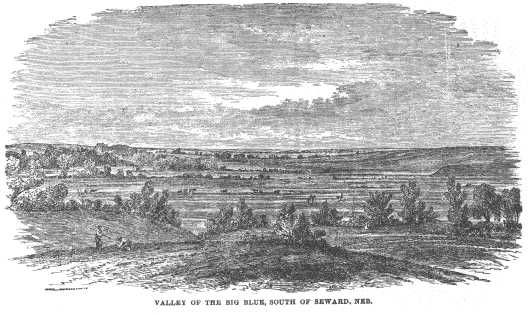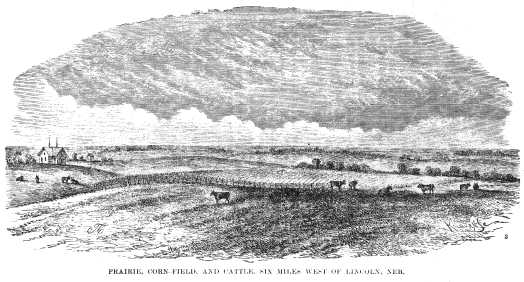

NEBRASKA THE GARDEN OF THE WEST.
"The prairie is substantially unbroken and homogeneous in its character, from the Valley of the Wabash to Fort Kearney. It is by nature an immense grassy plain, sometimes quite flat, generally more or less rolling, and occasionally broken by bluffs and sharp acclivities into a region not adapted to the plow. But I think that four-fifths, and probably seven-eighths, of the prairie States can be plowed with as little difficulty, and with as ample returns, as any part of the richest alluvial valleys of the East."
"Yet I speak advisedly, and not without a full impression upon my mind of the exceeding attractiveness and fertility of Iowa and Southern Minnesota, when I say that the most attractive country that I saw is west of the Missouri River. It is bounded on the north by the Platte, and on the south by the Kansas, and on the west by the valley of the Republican. I can see opportunities of a very flattering character in the West for at least three classes of industrious men. And, first, the poor man. By poor man, I mean a fellow who is not afraid of work, but who can't raise over $500 to save him. In going west, the first thing for him to do with a part of his $500 is to buy a span of plow-horses. Let him keep about $100 of the money in his pocket, to be spent for lumber and lime to put him up a cabin. It makes but little difference whether he rents for the first year, and takes two-thirds of his wheat, corn and barley, or buys a little tract of his own at the outset. In fact, I believe those who rent for a year or two, do better in the end, because they go to school to a first-class farmer who has experience; and no man can go into the grain business on a prairie successfully without a good deal of experience, or very careful and constant advice from his neighbors. An excellent business for a thrifty fellow is to get four horses, if he can, and break prairie at $3 an acre. There is no difficulty about getting any amount of prairie to break at this price. He can break two acres a day, making his earnings $6, and the feeding his horses can be done for $1.50. When he is not breaking for others he can be at work for himself. Another class is the comfortable farmer, who can sell out for $2,000 or $3,000. The third class to whom I think the great West holds out special inducements is the man who has $10,000 or over, and fancies "big farming." That

By the United States Agricultural Report, the average crops of Nebraska, and her comparative rank, for 1872, are as follows.
|
Oats, first, 40 bushels per acre, |
California, second, 38.5 |
|
Barley, " 31.6 " " |
Wisconsin, " 28.6 |
|
Buckwheat, first, 27.1 bushels per acre, |
Maine " 25.5 |
|
Sorghum, first, 141 gallons per acre, |
Missouri, " 113 |
|
Rye, third. 21.5 bushels per acre, |
California, first, 29.1 |
|
Grasses, third, 1.40 tons |
California, " 1.44 |
|
Potatoes, fourth, 120 bush. |
Iowa, " 133 |
|
Wheat, Sixth, 17.5 " |
Minnesota " 18.7 |
|
Corn, seventh, 39 " |
Iowa " 40.5 |
Last year the Nebraska corn average was as large as that of Iowa this year, and it would be as large this year, were it not so new a State, and hence so large a proportion of its corn area planted with sod corn.
Its prairies roll, and hence roll away the swamps and swamp agues which are so common in Illinois. Their nature is apparent in the VIEWS appended. Its northern boundary is half a degree further south than that of Iowa, and that most northern half degree of Iowa was left untouched until all other sections had been occupied. Iowa had been a State eight years before she had a mile of railroad, and Illinois tweuty-three years, but more than 300 miles of such a road had been finished in Nebraska on the day she was admitted into the Union, and 200 miles more were added the same year, forming the central member of an inter-oceanic railroad, the only one, as yet, in operation across the American continent, or likely to be for a long time. The miles of Nebraska railroad already exceed twelve
Illinois and Iowa movements for a Herd Law to fence cattle in instead of out, and make fences a superfluity, have proved failures, those of Nebraska have proved a success. In thus fencing cattle in instead of out, the Nebraskans have learned a lesson from the Manitoban, who strips and lies down with his mosquito bar open, but when he finds it filled with buzzing insects, slips out slyly, claps it to, and sleeps unmolested outside. The cost of fences in the United States is over seventeen hundred and fifty millions. Happy is Nebraska if she can escape that incubus.
Diversity of products is the basis of all commerce. But the products of Iowa and Nebraska are substantially identical. When Nebraska carries corn to Iowa, she carries coal to Newcastle. Now, westward of Nebraska, there is no such identity of products. The higher slopes of the Rocky Mountains are marked by the hand of nature as the paradise of grazing, but their altitude is too great for grain to grow. All the regions beyond - Utah, Nevada and California - are world-famous as preeminently mining, but not as agricultural land. Accordingly, Nebraska crops of oats, corn and hogs, from the first found their best market westward, and they find it doubly good there since the advent of railroads.
© 1998, 1999, 2000, 2001 for the NEGenWeb Project by T& C Miller